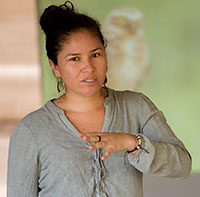When Kim Spencer, an Indigenous woman in Guyana’s isolated South Rupununi region, was 16 years old, she joined the South Rupununi Conservation Society (SRCS), a local grassroots conservation group. One of Spencer’s first experiences with SRCS was serving as a field assistant to a female PhD researcher, who inspired her to continue building understanding of the unique local ecosystems – and what’s required to safeguard them for future generations.
Spencer didn’t plan on becoming a teacher. But due to limited educational and employment opportunities, the following year she found herself teaching mathematics at the local Sand Creek Secondary School, with a class of over 30 students between the ages of 12 and 15.
Given the dearth of secondary schools in the region, most of Sand Creek’s students live far away from the school and reside during term-time in its dormitories. Observing that these children had few opportunities to participate in structured after-school activities besides sports – and seeing how little was being done to get them interested in conservation – Spencer formed a wildlife club. The club proved popular with many students, who especially enjoyed the field trips she took them on. Sometimes, Spencer found it challenging to stay motivated, as a full-time teacher with demanding responsibilities. But she pressed on: “I didn’t want to let my students down,” she said.
In 2019, the Sustainable Wildlife Management (SWM) Programme in Guyana partnered with the SRCS and supported the coordination of several projects – including environmental education for Indigenous youth. Spencer became involved in developing an environmental education curriculum for the region, providing expertise as a teacher and environmental activist. When the curriculum was completed, she was one of the teachers trained to teach it at her school, alongside three other pilot schools in South Rupununi. “I learned a lot from the training about how to engage the students better and make it fun, while ensuring they are learning about important things in the environment,” she said.
The curriculum is knowledge-based, and teaches young people about their wildlife, environment, and culture through several practical activities. It’s implemented through weekly sessions that combine traditional and scientific knowledge, and feature field trips to nearby savannahs, rivers, and forest areas. Notably, the children learn that they can acquire significant knowledge about wildlife and the environment through being curious, committed, investigative, and honest – just like Spencer.
The body of work is divided into three terms. The first is dedicated to learning about the animals and plants of the Rupununi; the second is on geography, hydrology and landscapes; and the final term focuses on culture, language and resources. It ends with an exhibition organized by the students and teachers to showcase what they learned during the school year to their parents and the wider community.
The curriculum has been widely successful and has encouraged young teachers like Spencer to continue to pass on their knowledge and skills to local youth. It has now been implemented in twelve schools in South and Central Rupununi: 500 Indigenous youth have attended the classes, and 55 teachers – of whom 33 are women – have been trained to teach the curriculum. To date, 13 Indigenous communities have been involved.
As a result of Spencer’s work in environmental education, she was recently selected as a Fellow in Conservation International’s Amazon Indigenous Women’s Fellowship program. Through this, she is pursuing a project to inspire, empower, and build the leadership capacity of young Indigenous women in the Rupununi to become environmental leaders. “I really believe I was selected because of my passion for conservation and environmental education – and the experiences I’ve had with the SRCS and the SWM Programme,” she said.
As Spencer’s example illustrates, female role models offer a powerful way to inspire younger women in sustainable wildlife management leadership. As such, the SWM Programme in Guyana continues to support women leaders in conservation in the Rupununi.
Spencer said she looks forward to working alongside the SWM Programme in her new project. “Teachers are important to our communities,” she said. “We have the privilege of guiding children for their future, which is something we should take seriously. Our children are our future. Everyone wants a good future, right?”
The SWM Programme in Guyana is part of an initiative from the Organisation of African, Caribbean and Pacific States (OACPS), funded by the European Union with co-funding from the French Facility for Global Environment (FFEM) and the French Development Agency (AFD). It is being implemented by a dynamic consortium of partners that includes the CIFOR, the Food and Agriculture Organization of the United Nations (FAO), the Wildlife Conservation Society, and the French Agricultural Research Centre for International Development (CIRAD). Its aim is to improve food security and the conservation and sustainable use of wildlife in forest, savannah, and wetland environments in 15 countries.
For more information about the SWM Programme in Guayana, contact Nathalie van Vliet at nathalievanvliet@yahoo.com.
We want you to share Forests News content, which is licensed under Creative Commons Attribution-NonCommercial-ShareAlike 4.0 International (CC BY-NC-SA 4.0). This means you are free to redistribute our material for non-commercial purposes. All we ask is that you give Forests News appropriate credit and link to the original Forests News content, indicate if changes were made, and distribute your contributions under the same Creative Commons license. You must notify Forests News if you repost, reprint or reuse our materials by contacting forestsnews@cifor-icraf.org.
















